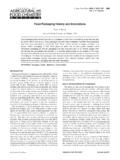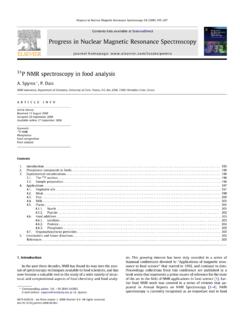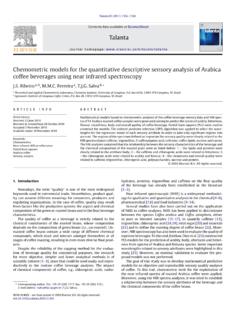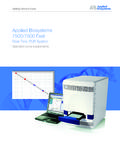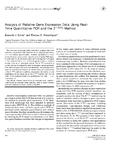Transcription of Characterization and quantification of saponins …
1 Characterization and quantification of saponins and flavonoids in sprouts, seedcoats and cotyledons of germinated black beansD. Guajardo-Flores, M. Garc a-Pati o, D. Serna-Guerrero, Guti rrez-Uribe, Serna-Sald var Departamento de Biotecnolog a e Ingenier a de Alimentos, Centro de Biotecnolog a, Tecnol gico de Monterrey-Campus Monterrey, Av. Eugenio Garza Sada 2501 Sur, 64849 Monterrey, , Mexicoarticle infoArticle history:Received 24 August 2011 Received in revised form 17 February 2012 Accepted 6 March 2012 Available online 16 March 2012 Keywords:Black beansSeed coatsCotyledonsSproutsSaponinsFlavonoids GerminationabstractSaponins, flavonols and isoflavones were quantified in sprouts, cotyledons and seed coats of black beans(Phaseolus vulgarisL.) subjected to germination over five days. Sprouts had a higher concentration of sap-onins compared to cotyledons or seed coats (p< ).
2 The saponins concentration in hilum after soaking. After the first day of germination, the saponin concentration in sprouts and coty-ledons increased and , respectively. Additional germination days decreased the amount of themost abundant soyasaponins in black bean sprouts. Flavonols and isoflavones were associated with seedcoats and less than one third of the initial amount remained after the soaking process. The concentrationsof flavonols were also reduced during germination process. Aglycones were detected only after soakingand their concentration remained unchanged during germination. Genistein was detected only afterthree days of germination. In general, one-day germinated black beans could be recommended forincreasing the concentration of saponins and non-glycosylated flavonols in sprouts and seed coats,respectively.
3 2012 Elsevier Ltd. All rights IntroductionSaponins are present in trace amounts in common beans,approximately sevenfold less compared to soybeans (Rupasingheet al., 2003). They can be divided into groups A, B or E based onthe structures of aglycones (Rupasinghe et al., 2003; Shiraiwa,Harada, & Okubo, 1991a; Shiraiwa, Kudo, Shimoyamada, Harada,& Okubo, 1991b). Group A saponins have glycosyl groups attachedto the C-3 and C-22 positions of the aglycone whereas thosebelonging to groups B and E are glycosylated only in the C-3 posi-tion. Group E saponins contain a ketone in C-22 instead of the hy-droxyl group found in counterparts belonging to group B. Group Bsaponins also exist in the plant as conjugates of 2,3-dihydro-2,5-dihydroxy-6-methyl-4H-py ran-4-one (DDMP) at C-22 (Kudouet al., 1992). The DDMP conjugates are thermally labile and caneasily be degraded due to its relatively weak covalent bond(Berhow, Kong, Vermillion, & Duval, 2006; Decroos et al.)
4 , 2005).Along with isoflavones, saponins change during germinationdue to synthesis and accumulation (Paucar-Menacho, Berhow,Mandarino, Chang, & de Mejia, 2010a; Paucar-Menacho, Berhow,Mandarino, de Mejia, & Chang, 2010b). The relevant change incomposition enhances the overall nutritional value of the soybeansand the contents of health-promoting phytochemicals (Bau,Villaume, & Mejean, 2000). These changes have also been reportedin black beans (Phaseolus vulgarisL.) but only for phenoliccompounds (Diaz-Batalla, Widholm, Fahey, Castano-Tostado, &Paredes-Lopez, 2006).To the best of our knowledge, however, no previous studies onthe fate of saponins in the different anatomical parts of commonbeans subjected to germination. The aim of this research was toidentify and quantify saponins in the sprouts, seed coats and coty-ledons of black bean seeds (P.
5 VulgarisL.) using HPLC MS-TOF andHPLC UV ELSD techniques. Furthermore, we tested the effect ofsoaking, drying and sprouting (1 5 days) on the concentration ofthese compounds along with other bioactive phytochemicals suchas flavonols and Materials and Plant materialsThe black bean variety used for the experiments was San Luis collected from a local distributor. The seeds were first cleanedusing sieves to remove dockage and splits and then with a dampcloth to remove surface dust. Malting tests were carried out withindividual lots of lot was soaked in distilled water (1:3, w/v) over 24 h withaeration at 500 ml/min provided by an aquatic pump. Then, thesoaking water was discarded and the resulting wet seeds were0308-8146/$ - see front matter 2012 Elsevier Ltd. All rights Corresponding author.
6 Tel.: +52 81 83284322; fax: +52 81 Serna-Sald var).Food Chemistry 134 (2012) 1312 1319 Contents lists available atSciVerse ScienceDirectFood Chemistryjournal homepage: on germination trays in a dark chamber set at 20 C and 92% relative humidity for 5 days. Samples were taken daily for thedetermination of germination percentage and sprout length andthen immediately dehydrated in an oven set at 60 C for 4 h. Thepercentage of solid loss was calculated from the difference inweight between raw and germinated dried seeds. The germinatedseeds were physically separated into sprouts, seed coats and coty-ledons. Each anatomical part was weighed, ground into a powder(Coffee and Spice Grinder Krups GX4100, DF, Mexico) and storedin a freezer at 80 C until Extraction of bioactive constituents of black beanAfter homogenization, g of each sample were accuratelyweighed and extracted with 25 ml of 80% aqueous methanol(DEQ Monterrey, Mexico).
7 Extraction was carried out in a Vortemp(Vortemp 1550, Labnet International, Inc. Edison, NJ) for 30 min g and 25 C using eight 5 mm glass beads (KIMAX, Vineland,NJ). Then, the resulting extract was filtered using a No. 1 Whatmanfilter paper and the solids were washed with 80% methanol to ad-just to a final volume of 25 ml. The extract was evaporated undervacuum at 60 C (Speedvac concentrator, Savant SC210A, Thermoelectron Co., Milford, MA) to eliminate the methanol and thenfreeze-dried (Virtis freezemobile Sentry , Gardiner, NY). Identification and quantification of saponins , flavonols andisoflavonesSaponins and flavonoids were quantified using an HPLC DAD ELSD (Agilent Technologies, Santa Clara, CA) system. Separationwas performed in a Zorbax SB-Aq mm ID 150 mm, re-verse column (Agilent Technologies, Santa Clara, CA) with a flow ml/min.
8 Elution was conducted with (A) HPLC-grade water ad-justed to pH 2 with trifluoroacetic acid (Sigma, St. Louis, MO) and(B) HPLC-grade acetonitrile. Separation was achieved with 20% Bfor the first 6 min, increasing the B concentration to 50% at12 min and to 100% at 30 min. This last solvent concentrationwas maintained for the next 10 min. Chromatograms were ac-quired at 220, 280 and 320 nm and integrated by the HP-AgilentSoftware (Chemstation for LC Copyright Agilent Technologies,1990 2003). Peak identification of flavonoids was based on reten-tion time and UV spectra. Aglycones were compared to authenticstandards of kaempferol, quercetin, myricetin and genistein. Toconfirm the detection of the DDMP-conjugated saponins theirabsorption maximum at 295 nm was identification of saponins in black bean extracts was con-firmed by HPLC MS-TOF (Model G1969A Agilent 1100 Santa Clara,CA).
9 Chromatographic conditions used were the same as those de-scribed for the HPLC DAD ELSD analysis. Mass spectra were col-lected using electrospray source in positive mode (ESI+) underthe following conditions:m/zrange, 100 1500; nitrogen gas; gastemperature, 350 C; drying gas flow rate, 13 l/min; nebulizerpressure, 50 psig; capillary voltage, 4000 V; and fragment voltage,70 V. The identification of saponins based in the mass spectra waseasier in view of the fact that they always presented the [M+Na]+and/or [M+K]+ions (Lee, Chen, Hwang, & Hsu, 1999). Extractedion chromatograms were obtained considering accurate mass ob-tained for the saponins or their adducts with Na or K with an errorrange of units using the Analyst QS software (AppliedBiosystems, Carlsbad, CA). The mass spectrum of each ion wasobtained to confirm the presence of the different ions forms ofthe saponins and/or corresponding fragments previously saponins were quantified using the evaporate light scatter-ing detector (ELSD) (Decroos et al.)
10 , 2005; Rupasinghe et al., 2003)and calculated by using a standard curve obtained from soyasapo-nin I purified in our laboratory. Flavonoids were quantified usingstandard curves from authentic standards of aglycones. For glycos-ylated flavonols the concentrations were reported as equivalents Statistical analysisAll analyses were done in triplicate and results were expressedas mean standard deviations. Statistical analyses were conductedby one-way ANOVA, and differences among means were comparedwith Tukey s tests with a level of significance ofp< using theJMP Version 5 software (SAS Institute Inc., Cary, NC, USA).3. Results and Physical changes during germinationThe solids loss after soaking averaged and did not in-crease significantly during germination (Table 1). These losseswere attributed to the degradation and oxidation of starch andsugars during the respiration process (Rupasinghe et al.
